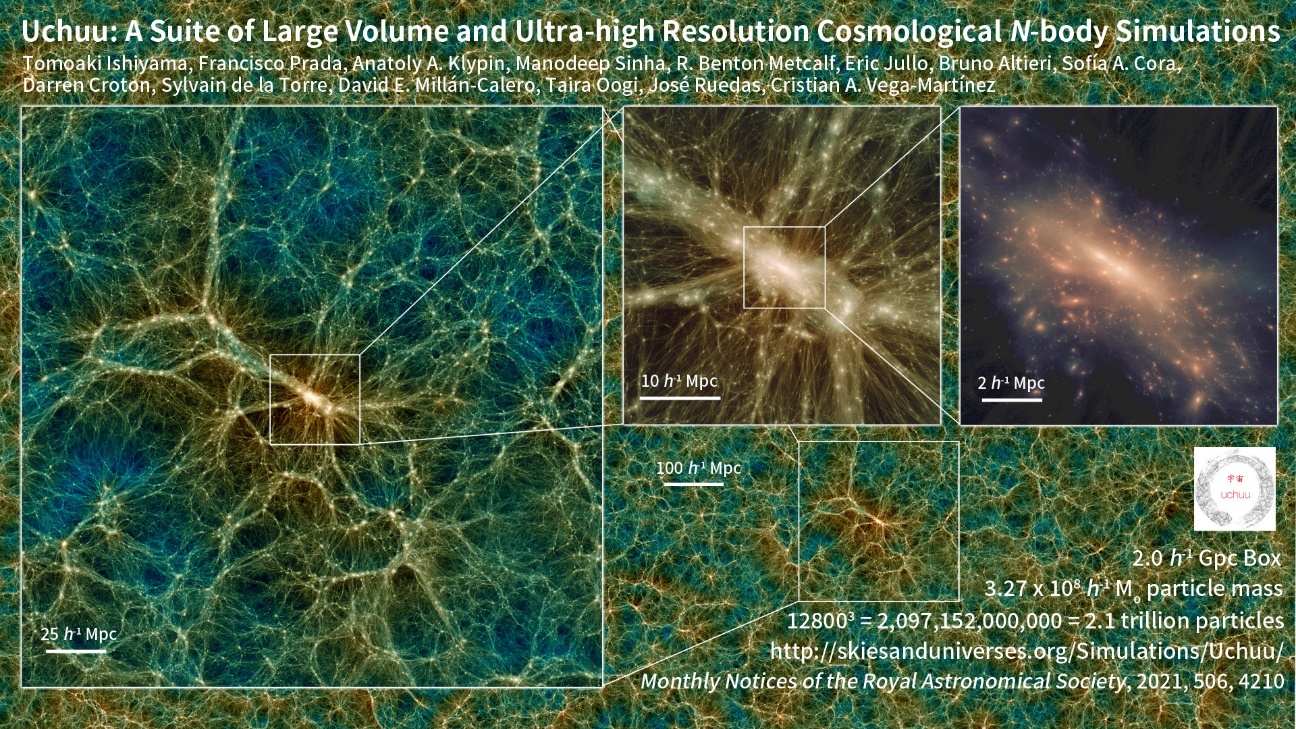The IAA is participating in the development of 'Uchuu', the most accurate and complete simulation of the universe.
This virtual creation offers the possibility of moving forwards and backwards through the history of the universe, thus allowing the evolution of its structure to be studied on a large scale.
The simulation, which has been developed in collaboration with the Instituto de Astrofísica de Andalucía (IAA-CSIC), can be consulted free of charge in the cloud.
An international team of researchers has developed the most realistic simulation of the universe to date. The creation, named Uchuu (which means universe in Japanese) has been made possible thanks to ATERUI II (Japan), the most powerful supercomputer in the world, built by the National Astronomical Observatory of Japan (NAOJ) to facilitate the understanding of different astronomical phenomena from a theoretical point of view. This virtual universe, which was developed with the participation of the Instituto de Astrofísica de Andalucía (IAA) of the Consejo Superior de Investigaciones Científicas (CSIC), can be used by research groups and cloud users free of charge.
"We hope that Uchuu will allow us to study the evolution of the universe with an unprecedented level of detail and volume of information, including the singularity of being able to observe different moments in its time dimension, practically from after the Big Bang to the present", says Francisco Prada, researcher at the IAA-CSIC. In addition to this institute, the CESGA (Galician Supercomputing Centre) and other research groups from Japan, the United States, Argentina, Australia, Chile, France and Italy are also participating in the project.
From the structure of the universe itself to individual galaxies
This simulation consists of 2,097,152,000,000 (2.1 trillion) particles in a cube 9.63 billion light years on a side. Roughly, the size of Uchuu is comparable to half the distance between the Earth and the most distant galaxies observed. Julia Ferrer, a researcher at the IAA-CSIC who uses Uchuu to study the large-scale structure of the Universe, says: "No other simulation is able to show so much information while maintaining a high resolution. Normally you have to choose between one of the two variables".
Another of the most characteristic features of this virtual creation is its ability to simulate the evolution of matter over almost the entire age of the universe: 13.8 billion years of history, thirty times the time since animal life on Earth first emerged from the oceans. "What makes Uchuu different is that you can decide what time in the universe you want to study", says Ferrer. "You can also observe dark matter halos and their behaviour or, if you prefer, zoom in and focus on clusters of galaxies or individual galaxies". The simulation will allow researchers to pose certain scenarios, such as the collision of two black holes in the past, and study these phenomena without the need for direct observations.
A catalogue of almost one million freely accessible photos
To produce Uchuu, the researchers used all available processors of the ATERUI II supercomputer for an entire year; 40,200 CPU cores working for 48 hours every month to make this project a reality. Tomoaki Ishiyama, an associate professor at Chiba University in Japan, was in charge of developing and running the code that would create this simulation. The result, says Ishiyama, "is 3 petabytes of data, the equivalent of almost a million photos from a 12-megapixel mobile phone".
Storing such a large amount of information and compressing it into a format that can work even in the cloud is no easy task. The researchers had to resort to the use of high-performance computational techniques. IAA-CSIC researcher José Ruedas, in charge of developing the Skun6 computational infrastructure, has been involved in the whole process, "with the collaboration of the RedIRIS group, the Spanish Academic and Research Network, through its High-Speed Data Transfer Service, and the IAA-CSIC computing department', explains the researcher.

Dark matter distribution in Uchuu and Shin-Uchuu at the present epoch. The images show aspects of the large-scale structure of the Universe, such as filaments and voids, down to the smallest substructures that the resolution of this simulation has allowed.
CESGA, a joint centre of CSIC and the Xunta de Galicia, has been in charge of hosting all the simulation data. To house the up to 3 petabytes of data generated by ATERUI II, the Big Data system solutions architect Javier Cacheiro designed a special platform, Uchuu-BigData, which is hosted at the Galician Supercomputing Centre itself.
The Uchuu catalogue is now available in the cloud. It is completely free of charge, "which is quite surprising considering that these simulations are usually very expensive", says Ferrer. "We want to make Uchuu available to other research groups that may not have the capacity or the money to produce their own simulation. In the end, it's something that benefits all of us".
The products generated from this virtual universe will be key to better understanding the galaxy mappings to be obtained by the DESI and PFS ground-based experiments and the European Space Agency's (ESA) Euclid space mission. The Uchuu team is also working on a second data release that will include virtual galaxy catalogues and gravitational lensing maps.
Ishiyama, T., Prada, F., Klypin, A. A., Manodeep, S., Metcalf, R. B., Julio, E., Altieri, B., Cora, S., A., Croton, D., de la Torre, S., Millán-Calero, D. E., Oogi, T., Ruedas, J., Vega-Martínez, C., A.., The Uchuu Simulations: Data Release 1 and Dark Matter Halo Concentrations. Monthly Notices of the Royal Astronomical Society. DOI: https://doi.org/10.1093/mnras/stab175
Instituto de Astrofísica de Andalucía (IAA-CSIC)
Unidad de Divulgación y Comunicación
Silbia López de Lacalle - sll[arroba]iaa.es - 958230676
https://www.iaa.csic.es
https://divulgacion.iaa.csic.es

